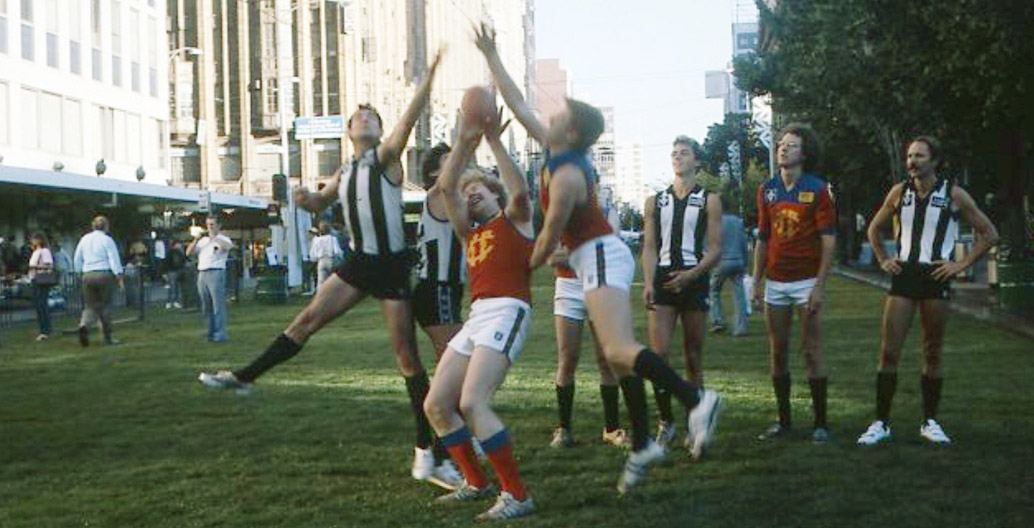
Imagine a city: Swanston Street Party and the greening of Melbourne
In 1985, Melbourne’s main thoroughfare, Swanston Street, was closed to traffic, covered with grass and a massive street party thrown in the name of the city’s sesquicentennial celebrations. For the party’s architects however, there was a larger agenda: to bring people back into the city.
It’s a February evening in 1985, on Melbourne’s Swanston Street. Down at the Flinders Street intersection, a road closed sign swings gently while a policeman redirects traffic away from the city centre. His elbow-length white gloves articulate instructions in frank, vaguely theatrical gestures. On the footpath, a metre-high pile of rolled turf is a sign of what’s to come.
Overnight, hundreds of workers lay 13,250 square metres of fresh grass along four blocks of Swanston Street, between Flinders and Lonsdale Streets, crane 240 mature trees and palms into massive bespoke planters, along with thousands of flowers. There are five stages, outdoor tables and chairs, countless metres of bunting. Outside the Museum (now the State Library of Victoria), there’s a huge foam Mamenchisaurus, and projectors installed in buildings opposite the Town Hall are ready to cover its facade with polka dots.
Victoria’s 150th birthday celebrations are set to begin. Over the weekend of 9 and 10 February, roughly half a million people come out to play. At a cost of $550,000, it’s an expensive shindig. More than all that, however, the team responsible for the greening, led by Professor David Yencken, AO, then secretary of the Ministry for Planning and Environment, have another agenda. They intend to use the party as a catalyst to permanently transform Swanston Street, and by extension, the city itself.
“A street that had, a mere 24 hours before, been carrying 50,000 cars an hour, as well as trams and trucks,” former ministry urban designer James Lunday has written, “was well and truly greened”.
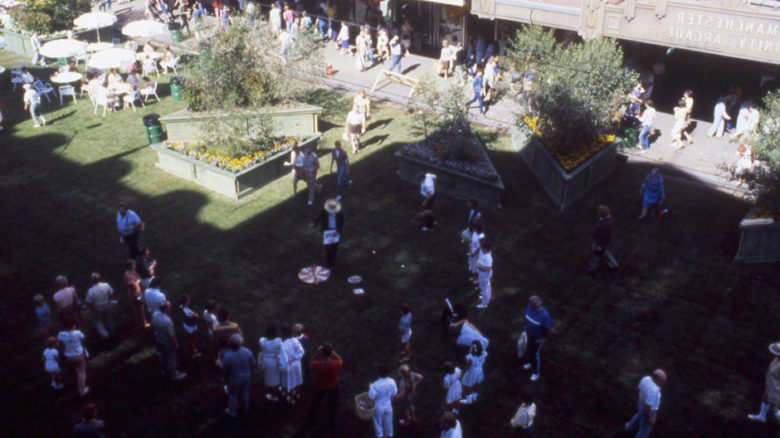
The 1985 'Greening' involved 240 mature trees, thousands of flowers and 13,250 square metres of grass.
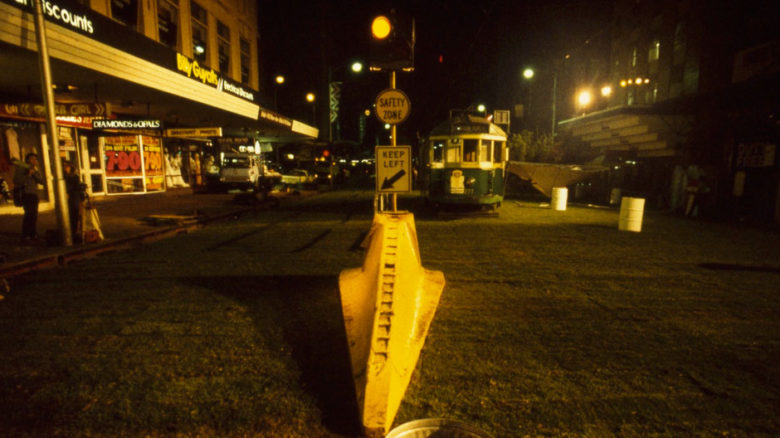
The fresh grass was laid over one night, covering four blocks of Swanston Street.
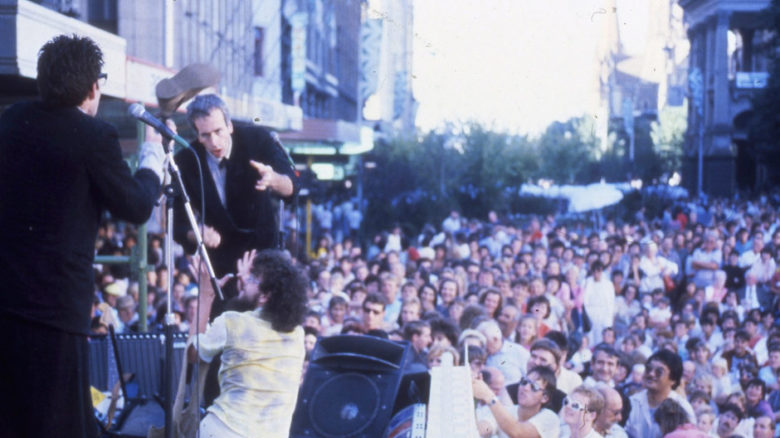
The Swanston street party helped Melbourne's citizens to imagine a livelier future for their city.
It’s difficult today to imagine Swanston Street as lifeless. However, when John Cain was elected Victorian premier in 1982, Melbourne and Victoria were slumped in economic recession. Much of the city’s 19th Century heritage had been eroded. Relaxed height controls had seen a surge of new high-rise office buildings, resulting in over-shadowed, windswept streets. As for Swanston Street, Robert Hoddle’s grand avenue had become a car-infested thoroughfare for traffic headed to and from the airport. For Lease signs dotted shopfronts. No one wanted to linger – there was no reason to. Journalist Kathy Kitzilas wrote in The Age in 1985:
“Swanston Street – you go through it. On your feet, on your bike or in the car. A couple of times a year the traffic stops. Moomba glides through for a Disneyfied hour or two and the Anzac march is as solemn as the protest marches are passionate. Then it’s back to normal. The traffic roars and jams.”
So what does it take to re-imagine a city? There’s a passage in Italo Calvino’s Invisible Cities, where Marco Polo describes a room filled with snow globes, each containing a different version of the city:
“These are the forms the city could have taken if, for one reason or another, it had not become what we see today. In every age someone…imagined a way of making it an ideal city.”
There have always been, and always will be, competing visions about the role of the main street in any city. In the case of Swanston Street, the state ministry team was pitted against the City of Melbourne, led to this day by Director of City Design Rob Adams.
At both state and local government level, the revitalisation of central Melbourne was seen as top priority, of which Swanston Street – “the prime ceremonial street”, according to Yencken – was key. But, much like Calvino’s snow domes, it was the ‘how’ where views diverged. “The view of the ministry was that [Swanston Street] should finally be fully paved as a pedestrian street. So that was one view. The city council, as expressed by Rob Adams…favoured partial pedestrianisation only.”
It’s a position Adams stands by. “I’ve heard people refer to Swanston Street as neither fish nor fowl, and I could be irritated by that. But we wanted a street that had public transport, had better access for bikes, had more walking area, and that still had some vehicles in it. So at any time of the day there’s something happening.”
In Cain’s newly formed Ministry for Planning and Environment, renowned architect Evan Walker was cutting his teeth in state politics. He appointed Yencken ministry secretary, who in turn assembled a team of internationally trained urban design talent: “a remarkably polyglot group of people from all around the world,” Yencken says.
In a testament to his leadership style, Yencken handed the sesquicentenary celebrations to the ministry’s two must junior staff, Sonja Peter and James Lunday.
“We came from backgrounds where you don’t accept the status quo,” Peter tells me over the phone from her studio in the Northern Territory. The Bavarian-born industrial designer brought to the ministry her Bauhaus-influenced design education, a keen interest in multi-disciplinary practice and environmental design. Not least, she brought her understanding of how European cities functioned – as magnets for people and as places to congregate. For his part, Lunday’s role revitalising his hometown of Glasgow after years of decrepitude had shown him how a city’s prospects could be revived.
While the pair wanted to spark people’s imaginations about how the city could look, they also wanted to build a case for removing traffic permanently from Swanston Street. “It was a protest about what cars do to a city, when you use a city as a sewer. And Swanston Street was a sewer for vehicles back then,” he says.
Peter cites being influenced by environmental artists such as George Nelson and Lawrence Halprin. “I was interested in the relationship of people to public and private space,” she says and elaborates on how the participatory nature of these works are essential: “It’s through the doing itself, that people will respond,” she says. Peter showed Yencken the work of Munich-based architect Hermann Grub via his book Stadtpark, Parkstadt (City-park, Park-city). One project in particular captured Yencken’s attention; it showed a small public street that had been filled with grass-covered cars.
“When I saw that [image], I realised this was another way of changing the character of whole streets,” says Yencken, “And that was the whole purpose of the exercise – it was to change people’s perceptions on how the street might be if it was changed, even for a very short time. So with great difficulty I got agreement [through] Evan Walker from the premier and cabinet to close Swanston Street for a weekend and to make it a party.”
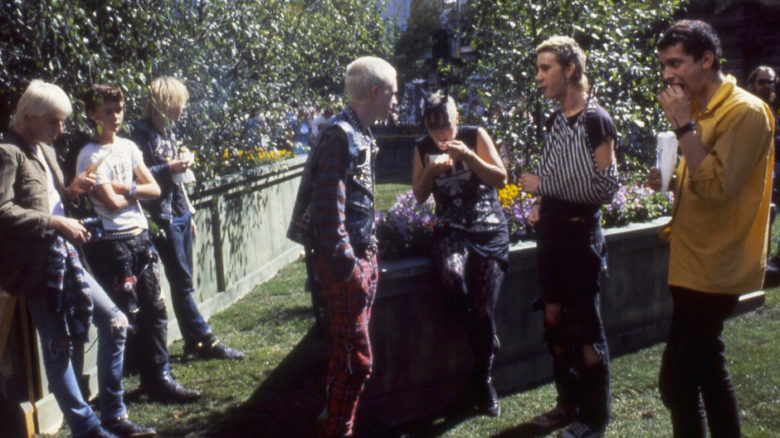
The 150th birthday celebrations drew an unprecedented crowd to Swanston Street.
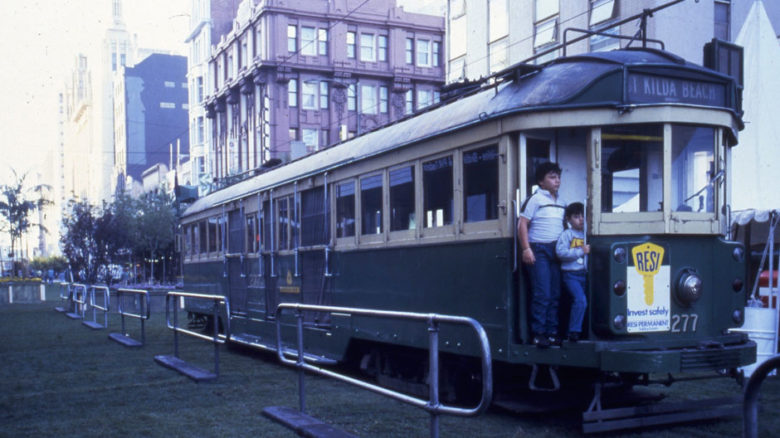
A beloved W-class Melbourne tram was centrepiece of the Swanston Street party.
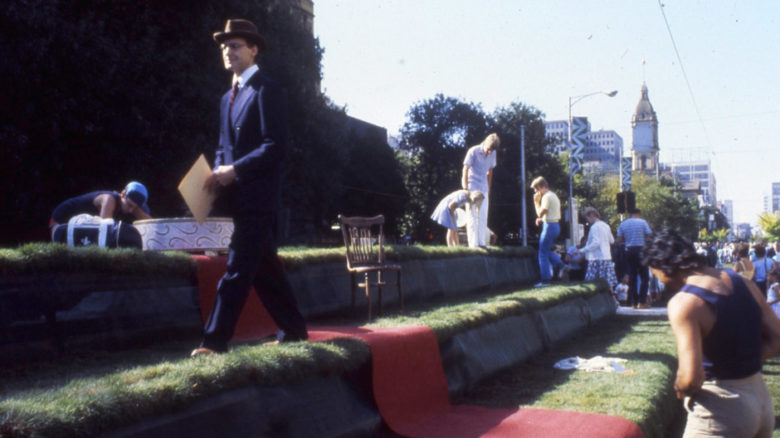
A performer gets ready to go on one of five stages.
After months of preparation, Peter remembers watching the crowds promenade, take in the performances, play ball, walk their dogs, or simply sit. The massive pop-up park had completely transformed the street and set to work on people’s imaginations.
“The acoustics changed, the smell and whole feeling changed, so people responded immediately to that,” says Peter.
When the wet grass became muddy, people took off their shoes and strolled along. Peter also recalls feeling vindicated upon seeing the reactions of the ministry staff who’d come down to help out.
“No-one knew what we had in mind, there was a lot of scepticism, and so to unroll the event by laying out the grass was spectacular.”
The grass had removed all trace of the traffic from the street, with the exception of a marooned W-Class tram standing as a proud centrepiece. The sun-warmed grass, wrote John Lahey in the Age,“smelled like the mouldering hay on a Gippsland farm”.
The greening nearly did not happen. With an election on the horizon, the opposition, led by Jeff Kennett, was quick to deride the Swanston Street Party as a vote-buying stunt.
“They missed the point that this was a serious attempt to show how the street might look following high quality pedestrianisation,” Yencken says. Under attack from the opposition, the premier’s support wavered. “[Cain] rang me to suggest that I go ahead without the green sward…I had to point out that that would destroy the whole purpose of the weekend.” Yencken managed to persuade the premier to let the greening proceed.
Despite everyone’s fears, the party was widely hailed a success, and awarded by the Australian Institute of Landscape Architects. But Yencken’s vision of green, experimental design was thirty years ahead of its time. “There was a wonderful opportunity to establish a tradition of taking a degraded area of the city and transform it imaginatively for a weekend. But after the greening I was already seen as someone who had madcap ideas, and if I continued to push that idea I would have been seen as not serious about the rest of my job.”
And while Yencken had to return to more conventional planning practices, for Peter and Lunday, it was all but impossible to slot back into their former roles in the Ministry.
“If you have stepped over management and done something that was outside the hierarchical structure, do you really want to go back into that structure?” Peter says. She took a role with the Aboriginal Land Council in Western Australia and has not returned to Melbourne. Lunday stayed on for a few more years, before moving to New Zealand to start his own urban design and planning practice.
The City of Melbourne’s Rob Adams remains appreciative of Yencken’s role in bringing about the Swanston Street Party, calling it a “gutsy move.”
“There’s a big trend now, with urban designers talking about guerrilla urban design and things like that, almost as though it’s never happened before. Well, Swanston Street Party would have to be the biggest one,” he says.
“We didn’t used to be scared of just trying something…we didn’t mind being innovative. New York now writes up the fact that they painted some spaces on Broadway and put a few pot plants out: Isn’t it revolutionary? And you’re going, ‘Guys? Thirty years ago? And it wasn’t painted, it was actually grass!’”
Thirty years on, and with the proposed Metro Rail tunnel foreshadowing more changes for the area, Yencken laments the loss of Swanston Street’s identity as a ceremonial avenue. “I understand why [Council] has designed the street the way they have…I can understand, of course, that the trams had to be there. I understand the wish to retain bicycle lanes on the way through. But it is a mess, I have to say.”
Lunday agrees. “To me, Swanston Street has been designed as a continuous transit mall. It should never have been that.” And while he too acknowledges the street is a vast improvement on its 1980s state, for him, it has become sterile. “My last few visits, I’ve felt Melbourne’s slipping again. It’s lovely, it’s fantastic, but it’s sanitised…Melbourne needs to find its cool again,” he says.
Ever the pragmatist, Adams stands by the work undertaken by the City of Melbourne over the past thirty years. “People might say, I wish it was a little cleaner, but that’s gentrification in a way. The energy and the diversity of that street is more real, it’s the grit of the city. I doubt anybody feels unwanted in Swanston Street. It’s not an absolute success, nothing ever is. Because cities are works in progress.”
Adams summarises the street in this way: “If you had to get some feeling of what Melbourne is about, Swanston tells you more than most…it’s a sort of amalgam, it’s a mini slice right through what Melbourne is like, right down to the two-dollar shops.”
In February 2018 Adams, together with co-editors Kim Dovey and Ron Jones, published their account of Melbourne’s development since the Swanston Street Party with Urban Choreography: central Melbourne 1985–. Somewhat fittingly, they launched the book at one of Melbourne’s more recent temporary installations, MPavilion.
Back at CH2, as I leave Adams’ office, I can see how one’s affection for Swanston Street could be reaffirmed each day. The hard surfaces are filtered through the canopy of thirty-year-old plane trees. On the street a twenty-something man with wild red hair and sideburns is pounding the keys of his nord synthesizer while an appreciative crowd pools around. Nearby, two men are negotiating their sleeping arrangements for the night, laying out their sleeping bags and jovially trying to get them both to fit in the elevated doorway they’ve chosen. Outside Brunetti’s, some young guys are parodying break-dancing. A curious four-year-old in a bright red dress tugs at her parents’ clothes – she wants to watch. As I head for the tram a man on a hoverboard, intent on his smartphone, nearly takes my toes off.
Perhaps, amongst all the hard-to-find bars, the magnetic interstitial spaces, the graffitied lanes and rooftop gardens housing sky-high beehives, a city needs one imperfect, crowded, mongrel of a street – one that lends itself readily to disruption, to protests and parades. I’m not sure you could ever design the perfect street. Perhaps we can only ever provide the right cues.
This story was originally published on Kill Your Darlings and has been updated with new information. You can read the original article here.


